Optimizing warehouse space is crucial for ensuring smooth operations and maximizing efficiency. In this article, we'll dive into some smart warehouse layout strategies that can help you make the most of your space without compromising on functionality or aesthetics.
The Importance of Effective Warehouse Layout
An effective warehouse layout is more than just arranging shelves and pallets; it involves strategic planning to improve workflow, reduce costs, and enhance productivity. A well-planned layout allows for better inventory management, easier access to products, and streamlined processes.
Understand Your Workflow
Before diving into the design, it is essential to understand your warehouse's workflow. Analyze the movement of items from receiving to storage, picking, packing, and shipping. Mapping out these processes helps in creating zones within the warehouse that cater to specific activities. For instance, high turnover items should be stored closer to the picking and packing areas to reduce travel time.
Implementing Zoning
Dividing your warehouse into zones based on activity type can significantly boost efficiency. Consider creating distinct areas for receiving, storage, picking, packing, and shipping. This helps in minimizing disruptions and allows employees to focus on specific tasks within their designated zones.
Receiving Zone
The receiving area should be spacious and equipped with the necessary equipment to handle inbound goods. Ensure that there is enough room for unloading and inspecting deliveries without obstructing other operations.
Storage Zone
The storage area is the heart of the warehouse. Optimize this space by utilizing vertical storage solutions such as shelving units and pallet racks. Implementing an organized labeling system can also help in quickly locating items and managing inventory efficiently.
Picking and Packing Zones
Picking and packing zones should be designed to minimize movement and streamline order fulfillment. Implement pick-to-light or voice-picking systems to enhance accuracy and speed. Ensure that packing stations are well-equipped with materials and tools for efficient packaging.
Shipping Zone
The shipping area should be strategically located near the exit to facilitate quick dispatch of orders. Ensure that it is equipped with tape dispensers, scales, and other necessary equipment to streamline the shipping process.
Utilize Vertical Space
Warehouses often have high ceilings that are underutilized. Make the most of vertical space by installing multi-level shelving units and mezzanine floors. This not only increases storage capacity but also helps in maintaining an organized environment.
Ergonomic Design
Consider the well-being of your employees by incorporating ergonomic solutions into your warehouse design. Use adjustable workstations, anti-fatigue mats, and equipment that reduces physical strain. An ergonomically designed warehouse can improve employee morale and productivity.
Invest in Technology
Modern technology can play a significant role in optimizing warehouse layout and operations. Consider implementing Warehouse Management Systems (WMS) to keep track of inventory in real time. Automated guided vehicles (AGVs) and robots can also help in reducing manual labor and increasing efficiency.
Conclusion
A smart warehouse layout requires thoughtful planning and execution. By understanding your workflow, implementing zoning, utilizing vertical space, focusing on ergonomic design, and investing in technology, you can create an efficient and visually appealing warehouse. Embrace these strategies to transform your warehouse into a well-organized, high-performing space.
Popular Warehouse Design Articles
Discover our most popular articles on warehouse interior design, providing top insights and solutions.

The Role of Technology in Modern Warehouse Design

Optimizing Logistics for Efficient Furniture Import and Export

The Art of Space Planning for Efficient Warehouse Design

